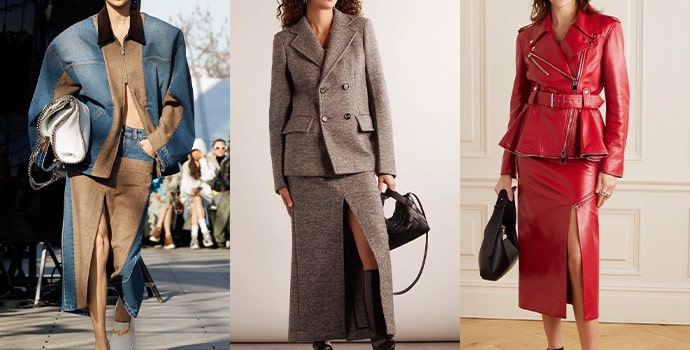How Branded Clothing Can Boost Confidence Through Fabric and Feel
How Branded Clothing Can Boost Confidence Through Fabric and Feel
Blog Article
The Relevance of Sustainable Garments: Exactly How It Impacts the Environment and Your Closet
Lasting clothing is increasingly recognized for its critical duty in decreasing the ecological impact of the fast style market. By concentrating on eco-friendly materials and moral production techniques, it resolves pressing environmental worries. This shift not just profits the planet however likewise affects consumer choices, leading to an extra thoughtful method to closet management. Comprehending these characteristics elevates vital concerns concerning fashion's future and individual obligation in shaping it.
The Ecological Footprint of Quick Fashion

Benefits of Sustainable Products
Sustainable materials offer substantial benefits, specifically with environmentally friendly fabric options that lessen environmental harm. These products also demonstrate durability and long life, decreasing the demand for regular replacements. Therefore, they contribute to a much more sustainable garment industry and promote responsible customer habits.
Eco-Friendly Fabric Options
While the fashion business has actually long been associated with rapid patterns and environmental damage, the surge of environmentally friendly textile options offers a transformative possibility. Sustainable products such as organic cotton, hemp, and Tencel have actually gotten appeal because of their lower eco-friendly influence. These materials are typically produced without harmful pesticides and call for less water, reducing their carbon footprint - Branded Clothing. In addition, lots of green materials are eco-friendly, adding to a circular economic situation by minimizing waste. Selecting lasting materials not only sustains environmentally responsible practices however likewise promotes much healthier environments. As consumers come to be much more familiar with their acquiring power, the demand for eco-friendly materials motivates brands to innovate and take on even more sustainable manufacturing methods, ultimately profiting the planet and future generations
Longevity and Long Life Advantages
Several customers are significantly recognizing the resilience and durability benefits of lasting products in their garments selections. Unlike standard textiles, lasting products such as natural cotton, hemp, and recycled polyester are engineered to stand up to wear and tear, resulting in garments that last much longer. This reduced regularity of replacement not only saves customers cash with time but likewise decreases waste created by quick fashion. Furthermore, lasting apparel frequently utilizes environmentally friendly production methods that improve material strength, adding to a reduction in the overall carbon footprint. By spending in sturdy clothing, consumers can grow a more lasting closet while enjoying premium pieces that maintain their aesthetic and capability with time. Longevity and durability stand as essential advantages of selecting sustainable products.
Lowering Waste Through Lasting Practices
Reducing waste in the fashion business can be attained through ingenious methods such as upcycling and repurposing materials. Furthermore, adopting minimalist closet strategies motivates customers to prioritize high quality over quantity, eventually lowering clothing usage. Together, these techniques add significantly to an extra lasting garments model.
Upcycling and Repurposing Products
Upcycling and repurposing products have emerged as innovative approaches in the garment industry, changing disposed of textiles into beneficial new products. This strategy not just reduces waste but likewise motivates creative thinking and individuality in clothes style. By taking old garments and products, developers can create distinct items that mirror personal style while minimizing the need for new resources. In addition, upcycling typically calls for much less energy and water compared to standard production procedures, substantially reducing the ecological impact of fashion. As consumers become much more familiar with sustainability, the popularity of upcycled clothing continues to rise, advertising a round economy. Ultimately, these techniques add to a more lasting future, where fashion focuses on environmental wellness over fast production and consumption.

Minimal Closet Approaches
As people progressively seek to reduce their ecological impact, adopting minimal closet methods has acquired traction as a reliable strategy to sustainable style. These approaches stress high quality over quantity, motivating customers to curate a smaller collection of versatile, sturdy garments. By concentrating on timeless items that can be blended and matched, individuals can lower the regularity of purchases and inevitably reduce waste.Additionally, minimalism promotes mindful usage, prompting buyers to review the moral and ecological ramifications of their selections. This strategy not only cultivates an extra lasting way of life yet likewise simplifies everyday decision-making relating to clothing. As people welcome minimalist principles, they contribute to a fashion society that values sustainability and accountable consumerism, ultimately bring look at this site about an extra eco-conscious society.
The Duty of Ethical Labor in Lasting Fashion
While lots of consumers are significantly knowledgeable about the ecological consequences of their clothing options, the value of ethical labor techniques in sustainable fashion can not be ignored. Ethical labor includes reasonable wages, risk-free working problems, and respect for workers' civil liberties, forming the backbone of accountable style production. Brands that prioritize honest labor not only uplift areas yet likewise set a requirement for responsibility in the industry.Moreover, the integration of moral techniques cultivates openness, enabling consumers to make informed selections concerning their purchases. This method contrasts dramatically with rapid fashion's unscrupulous labor designs, which often focus on revenue over individuals. By supporting firms devoted to ethical labor, consumers contribute to a system that values human dignity together with environmental sustainability. Honest labor is not simply an add-on; it is important to the broader goal of lasting fashion, making sure that the mission for eco-friendliness does not come at the cost of human rights.
The Impact of Lasting Apparel on Carbon Emissions
Lasting clothes has the potential to greatly lower carbon discharges connected with the garment industry. Standard garment production adds significantly to greenhouse gas emissions, largely as a result of energy-intensive manufacturing procedures and making use of non-renewable resources. On the other hand, lasting fashion concentrates on green materials, such as natural cotton or recycled fibers, which typically call for less energy to produce.Moreover, sustainable brands often tend to embrace much more effective production techniques, reducing waste and lowering total discharges. By focusing on toughness and classic layout, lasting apparel urges customers to purchase much less regularly, further lowering the carbon footprint connected with overconsumption.Additionally, lots of lasting brands are dedicated to openness in their supply chains, enabling consumers to make enlightened choices that align with their worths. Eventually, changing towards sustainable garments can bring about a considerable decrease in carbon emissions, adding to a much healthier earth and a much more lasting future for the garment industry.
Supporting Local Economic Situations With Lasting Selections
The shift toward sustainable clothing not only addresses ecological worries yet additionally considerably benefits local economies. By selecting sustainable fashion, consumers usually support small companies and regional craftsmens, improving neighborhood durability. These business commonly operate a smaller scale, prioritizing craftsmanship and ethical techniques over mass production.Investing in locally made sustainable apparel fosters job development and stimulates financial development within neighborhoods. As customers become much more familiar with the environmental effect of their acquisitions, they progressively choose items that mirror their worths. This demand urges neighborhood makers to adopt lasting practices, contributing to a round economy.Moreover, sustaining regional organizations minimizes transport discharges, aligning with eco-conscious consumer actions. The interconnectedness of sustainable clothes and local economies underscores the essential duty that private options play in promoting both ecological and financial wellness. By cultivating these regional connections, areas can flourish while also functioning towards an extra sustainable future.
Changing Your Storage Room: Tips for a Sustainable Wardrobe
As individuals seek to lower their environmental impact, changing a storage room right into a sustainable wardrobe becomes an essential action. One efficient method is to review existing apparel, maintaining only products that are worn routinely which line up with sustainability goals. Prioritizing top quality over amount is crucial; buying resilient pieces visit this web-site from green brands can substantially reduce waste.Additionally, integrating used items can revive a closet while minimizing environmental damage. Organizing garments swaps with friends or contributing unused products can better advertise sustainability.When shopping, individuals ought to seek materials that are natural, recycled, or eco-friendly, and stay clear of rapid style retailers - Branded Clothing. Finally, practicing mindful usage by thoughtfully thinking about each purchase can contribute to a much more lasting lifestyle. By executing these suggestions, one can produce a closet that shows personal style while supporting environmental stewardship
Regularly Asked Inquiries
Just How Can I Identify Lasting Apparel Brands?
To recognize lasting garments brands, one ought to research products made use of, look for certifications like Fair Trade, and check out the brand name's transparency about their production procedures, labor techniques, and environmental impact, ensuring moral and eco-friendly techniques are prioritized.
What Are the Prices Linked With Lasting Fashion?
The costs related to lasting fashion can vary considerably. Greater production costs, ethical sourcing, and environmentally friendly materials frequently lead to raised retail rates, which may deter some customers while attracting environmentally aware customers.
Can Sustainable Clothing Be Trendy and fashionable?
Sustainable clothing can without a doubt be stylish and stylish. Designers increasingly prioritize cutting-edge products and ethical manufacturing approaches, verifying that fashion and sustainability can exist side-by-side. Customers now have diverse choices that blend looks with ecological consciousness.
Just How Does Laundering Garments Affect Their Sustainability?
Cleaning clothes considerably influences sustainability by consuming water and power, adding to pollution, and triggering microplastic launch. Regular washing can break down textiles, reducing their lifespan and boosting the demand for replacements, eventually aggravating ecological concerns.
What Is the Lifespan of Sustainable Garments Contrasted to Rapid Fashion?
The lifespan of sustainable clothing commonly goes beyond that of rapid style items, frequently long lasting a number of years because of high quality materials and craftsmanship. On the other hand, quick style garments may deteriorate rapidly, requiring more regular replacements. Sustainable clothing is increasingly recognized for its crucial duty in minimizing the ecological effect of the rapid fashion sector. While lots of customers are progressively mindful of the ecological repercussions of their clothing choices, the significance of ethical labor practices in lasting style can useful reference not be neglected. Branded Clothing. Sustainable clothing has the prospective to significantly reduce carbon exhausts linked with the fashion industry. In contrast, sustainable style focuses on green products, such as organic cotton or recycled fibers, which typically require much less power to produce.Moreover, sustainable brand names have a tendency to adopt extra effective manufacturing methods, minimizing waste and reducing total exhausts. By prioritizing sturdiness and classic style, sustainable clothes encourages customers to buy much less frequently, more decreasing the carbon impact associated with overconsumption.Additionally, several sustainable brands are dedicated to openness in their supply chains, allowing consumers to make educated choices that straighten with their worths
Report this page